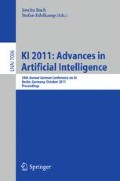Abstract
Natural body movements are temporal sequences of individual actions. In order to realise a visual analysis of these actions, the human visual system must accomplish a temporal segmentation of action sequences. We attempt to reproduce human temporal segmentations with Bayesian binning (BB) [8]. Such a reproduction would not only help our understanding of human visual processing, but would also have numerous potential applications in computer vision and animation. BB has the advantage that the observation model can be easily exchanged. Moreover, being an exact Bayesian method, BB allows for the automatic determination of the number and positions of segmentation points. We report our experiments with polynomial (in time) observation models on joint angle data obtained by motion capture. To obtain human segmentation points, we generated videos by animating sequences from the motion capture data. Human segmentation was then assessed by an interactive adjustment paradigm, where participants had to indicate segmentation points by selection of the relevant frames. We find that observation models with polynomial order ≥ 3 can match human segmentations closely.
Access this chapter
Tax calculation will be finalised at checkout
Purchases are for personal use only
Preview
Unable to display preview. Download preview PDF.
References
Agam, Y., Sekuler, R.: Geometric structure and chunking in reproduction of motion sequences. Journal of Vision 8(1) (2008)
Albu, A.B., Bergevin, R., Quirion, S.: Generic temporal segmentation of cyclic human motion. Pattern Recognition 41(1), 6–21 (2008)
Barbič, J., Safonova, A., Pan, J.Y., Faloutsos, C., Hodgins, J.K., Pollard, N.S.: Segmenting motion capture data into distinct behaviors. In: Proceedings of Graphics Interface GI 2004. Canadian Human-Computer Communications Society, School of Computer Science, pp. 185–194. University of Waterloo, Waterloo (2004), http://portal.acm.org/citation.cfm?id=1006058.1006081
Bishop, C.M.: Pattern Recognition and Machine Learning. Springer, Heidelberg (2007)
Bruderlin, A., Williams, L.: Motion signal processing. In: SIGGRAPH, pp. 97–104 (1995)
Chen, W., Zhang, J.J.: Parametric model for video content analysis. Pattern Recognition Letters 29(3), 181–191 (2008)
Dickman, H.R.: The perception of behavioral units. In: Barker, R.G. (ed.) The stream of behavior, pp. 23–41. Appleton-Century-Crofts, New York (1963)
Endres, D., Földiák, P.: Bayesian bin distribution inference and mutual information. IEEE Transactions on Information Theory 51(11), 3766–3779 (2005)
Endres, D., Oram, M.: Feature extraction from spike trains with bayesian binning: latency is where the signal starts. Journal of Computational Neuroscience 29, 149–169 (2009), doi:10.1007/s10827-009-0157-3
Endres, D., Oram, M., Schindelin, J., Földiák, P.: Bayesian binning beats approximate alternatives: estimating peri-stimulus time histograms. In: Platt, J., Koller, D., Singer, Y., Roweis, S. (eds.) Advances in Neural Information Processing Systems, vol. 20, pp. 401–408. MIT Press, Cambridge (2008)
Fearnhead, P.: Exact and efficient bayesian inference for multiple changepoint problems. Statistics and Computing 16(2), 203–213 (2006)
Flash, T., Hogan, N.: The coordination of arm movements: an experimentally confirmed mathematical model. J. Neurosci. (5), 1688–1703 (1985)
Green, R.D.: Spatial and temporal segmentation of continuous human motion from monocular video images. In: Proceedings of Image and Vision Computing, New Zealand, pp. 163–169 (2003)
Hutter, M.: Exact bayesian regression of piecewise constant functions. Journal of Bayesian Analysis 2(4), 635–664 (2007)
Ilg, W., Bakir, G., Mezger, J., Giese, M.: On the representation, learning and transfer of spatio-temporal movement characteristics. International Journal of Humanoid Robotics 1(4), 613–636 (2004)
Kschischang, F., Frey, B., Loeliger, H.A.: Factor graphs and the sum-product algorithm. IEEE Transactions on Information Theory 47(2), 498–519 (2001)
Marida, K.V., Jupp, P.E.: Directional Statistics. Wiley, Chichester (2000)
Newtson, D., Engquist, G.: The perceptual organization of ongoing behavior. Journal of Experimental Social Psychology 12(5), 436–450 (1976)
Omlor, L.: New methods for anechoic demixing with application to shift invariant feature extraction. PhD in informatics, Universität Ulm. Fakultät für Ingenieurwissenschaften und Informatik (2010) urn:nbn:de:bsz:289-vts-72431
Polyakov, F., Stark, E., Drori, R., Abeles, M., Flash, T.: Parabolic movement primitives and cortical states: merging optimality with geometric invariance. Biol. Cybern. 100(2), 159–184 (2009)
Quirion, S., Branzan-Albu, A., Bergevin, R.: Skeleton-based temporal segmentation of human activities from video sequences. In: Proceedings WSCG 2005 - 13-th International Conference in Central Europe on Computer Graphics, Visualization and Computer Vision 2005 (2005)
Roether, C.L., Omlor, L., Christensen, A., Giese, M.A.: Critical features for the perception of emotion from gait. Journal of Vision 9(6) (2009)
Shipley, T.F., Maguire, M.J., Brumberg, J.: Segmentation of event paths. Journal of Vision 4(8) (2004)
Wang, L., Hu, W., Tan, T.: Recent developments in human motion analysis. Pattern Recognition 36(3), 585–601 (2003)
Zacks, J.M., Kumar, S., Abrams, R.A., Mehta, R.: Using movement and intentions to understand human activity. Cognition 112(2), 201–216 (2009)
Author information
Authors and Affiliations
Editor information
Editors and Affiliations
Rights and permissions
Copyright information
© 2011 Springer-Verlag Berlin Heidelberg
About this paper
Cite this paper
Endres, D., Christensen, A., Omlor, L., Giese, M.A. (2011). Segmentation of Action Streams Human Observers vs. Bayesian Binning. In: Bach, J., Edelkamp, S. (eds) KI 2011: Advances in Artificial Intelligence. KI 2011. Lecture Notes in Computer Science(), vol 7006. Springer, Berlin, Heidelberg. https://doi.org/10.1007/978-3-642-24455-1_7
Download citation
DOI: https://doi.org/10.1007/978-3-642-24455-1_7
Publisher Name: Springer, Berlin, Heidelberg
Print ISBN: 978-3-642-24454-4
Online ISBN: 978-3-642-24455-1
eBook Packages: Computer ScienceComputer Science (R0)

